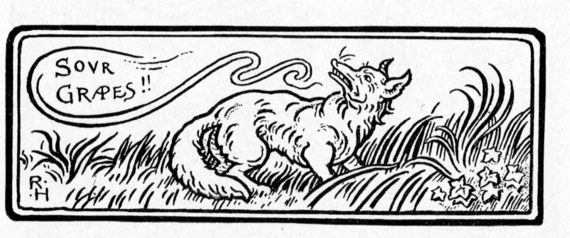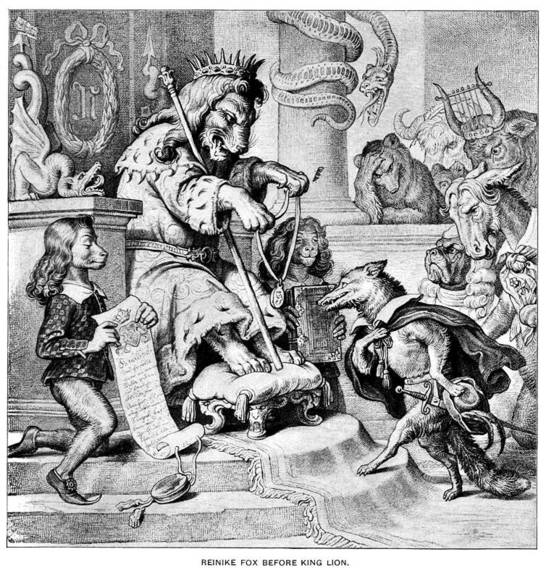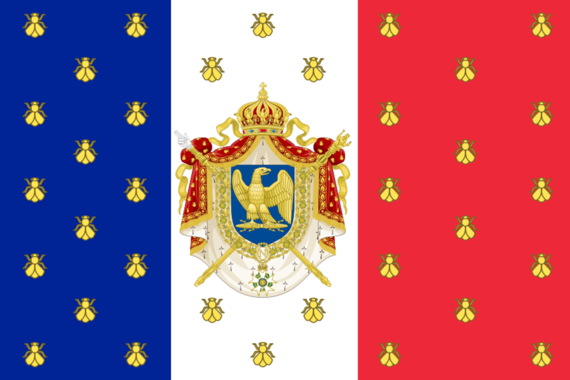It was almost a decade after the Puritan government of England had executed King Charles I, and the country had begun to descend into chaos. Oliver Cromwell, who ruled as Lord Protector silenced criticism by banning newspapers, intercepting letters, and employing a network of secret police. In his History of Four-Footed Beasts, Serpents and Insects, Reverend Edward Topsell wrote, "Would it not make all men reverence a good king set over them by God, seeing the bees seek out their king if he lose himself, and by a most sagacious smelling sense, never cease till he be found out and then bear him upon their bodies if he be not able to fly. . . ." Topsell then tried to add a bit of balance by continuing, "And what king is not invited to clemency and deterred from tyranny, seeing the king of bees hath a sting but never uses the same." We have no reason to think Topsell was a political dissident, in fact he may really have believed that he was simply recording the ways of bees. Consciously intended or not, a subtext comes through, and the English Parliament apparently agreed with it, since, two years later in 1660, it invited Charles II, son of the beheaded king, back to rule, requiring, however, that he not use his office for revenge against the regicides. Simply by speaking of animals, one participates in an ongoing process of cultural, and often political, negotiation.  J. J. Grandville, "Beehive," 1842
J. J. Grandville, "Beehive," 1842
The world of animals here appears parallel to that of human beings, and differences of species may stand in for those of tribe, gender, class, profession and so on. This is a sort of vision that we associate with "totemism," which the anthropologist Claude Levi-Strauss explained in the mid-twentieth century as the application of structures initially found in the natural world, especially among animals, to human culture, as a means of representing social distinctions among indigenous peoples. Apart from the vastness of their scale and the complexity of their organization, nations are essentially tribes, and the relations between them follow many of the same dynamics. Animal symbolism is so deeply embedded in human culture that it is almost impossible to talk about animals without, simultaneously, speaking indirectly about human beings.
Levi-Strauss' notion of totemism has been qualified, challenged and refined by subsequent thinkers, but, without trying to tease out all possible implications, it still serves as a rough working model for understanding how animals and nature may contribute to cultural diplomacy. This is apparent in the beast fables from the tradition of Aesop, a half-legendary storyteller from the Greek isle of Samos in the seventh century BCE. Several of the stories commonly attributed to him such as "The Tortoise and the Hare" or "The Fox and the Grapes" are still familiar to contemporary people from childhood. Behind the moralistic tales of talking lions and foxes, we can discern a tribal religion, with its animal totems, deities, sages and tricksters, largely deprived of their numinous qualities yet, nevertheless, in ways not terribly different from those of many indigenous peoples of Africa or the Americas.  Richard Heighway, illustration to Aesop's "The Fox and the Grapes," 1910
Richard Heighway, illustration to Aesop's "The Fox and the Grapes," 1910
From very early times, the fable has been primarily, though by no means exclusively, a form associated with slaves. Aesop, Phaedrus and Babrius - the three most celebrated fabulists of the ancient world, were all slaves, as was Uncle Remus, the mouthpiece for Afro-Indian tales in the Aesopian tradition, collected by Joel Chandler Harris in the deep south of the United States just after the Civil War. The fable enabled slaves, as well as people of other social orders, to indirectly express things which might otherwise be sensitive or forbidden.
Totemism became even more overt in the High Middle Ages, with the development of heraldry. This was initially a system of emblems painted on shields to identify knights in jousts, when their faces and bodies were completely covered by armor. In the most literal way, heraldic symbols were a substitute for the human face. Heraldry was gradually extended to feudal families, and then to states, businesses, clubs and almost all other institutions. These symbols were by no means confined to animals and vegetation, but creatures such as boars, wolves, bears, lions and eagles figured very prominently. Heraldry represented identity in terms of abstract relationships among symbolic objects, which are joined in fantastic patterns with no regard for common sense. They are deliberately esoteric, pointing to the mystery which is ultimately at the core of identity.  Crest of Britain with the Lion of England and the Unicorn of Scotland
Crest of Britain with the Lion of England and the Unicorn of Scotland
In some contexts at least, modern societies have identified with animals with constancy comparable to that of tribal peoples. These creatures need not necessarily be indigenous, wild, contemporary, or even real. England is represented by the lion, which is not indigenous, or the bulldog, which is a domestic breed. The animal representing Mauritius is the extinct dodo, while Scotland is represented by the mythical unicorn. Those are simply animals that ─ whether for historical, folkloric, commercial or geographic reasons ─ seem to embody a nation's uniqueness. Underlying this totemic practice is an implicit analogy between the diversity of human cultures and that of all living things.
The animals in fables of the Renaissance, such as those of La Fontaine, and of political cartoons, are essentially those of heraldry. The totemic notion that animals constitute a world parallel to that of people was also responsible for the practice of physiognomy, which held that the character of a person could be read by the resemblance of his features to certain animals, so there would be wolf people, pig people, bat people and so on. That tradition, without the theoretical underpinnings, continues in caricatures and, most especially, political cartoons up through the present day, as well as in literary works such as Orwell's Animal Farm.  Illustration by Wilhelm Kaulbach's to Goethe's "Reineke Fox," c. 1830
Illustration by Wilhelm Kaulbach's to Goethe's "Reineke Fox," c. 1830
One might perhaps think that the stylized animals of literary fables, heraldry and editorial cartoons are too detached from their original models for their representation to have much impact on relationships between human beings and the natural world; experience suggests otherwise. White-tailed deer, turkeys and Canada geese, though on the brink of extinction in the early twentieth century, may now be more common in the United States and Canada than they were in preColumbian times. Bald eagles, moose, beaver, buffalo, and coyotes are making significant comebacks as well. These resurgent animals are precisely those that have great iconic importance in both Amerindian and immigrant cultures. The bald eagle is the national animal of the United States, and the beaver of Canada. The turkey is an old symbol of the New World, the buffalo of the Great Plains, and moose of the far North. All of the others as well are closely identified with certain regions, landscapes or peoples.
To be sure, iconic status in human culture can often endanger animals. In the United States immediately following the Civil War, the American buffalo were deliberately hunted almost to extinction, in order to dishearten the Plains Indians, in whose lives they had a central role. In Asia today, the South China tiger is being hunted to extinction in large part because of the central role that its body parts play in folk medicine. But such events simply show another aspect of the way cultural and natural concerns are inextricably bound together.
The United States Bureau of Fish and Wildlife currently lists about 500 species as "endangered" and about another 200 as "threatened." The many thousand additional species have been proposed for these lists. Having a local species listed can bring publicity and status as well as money for conservation, as well as less-tangible psychological satisfactions, but there is no clear criterion for either categorization. Inclusion is, therefore, a subject of continual lobbying, in which it is not always easy to tell cultural or economic motives from environmental ones.
The mediation performed by animals in human affairs is continuous, if seldom noticed, like the sound of crickets on an autumn day. In the past, this process has occasionally emerged from the background, as when Harun al Rashid gifted two leopards to Charlemagne or, in 1972, when the government of China presented a mated pair of pandas to the National Zoo in Washington, D. C. It is hard to say how much ecological awareness, if any, is reflected by either of these gifts. But the presents were at the least a reminder to the recipient that the distant land contained not only wealth and people but also natural wonders.
My broader point is that environmental problems are also cultural, in fact one cannot address one apart from the other. In general, we can say that the representation of people in terms of animals and nature, an essentially totemic tradition, can place human concerns in a broader perspective, diffusing tensions and helping us to:
•Look beyond immediate personal or collective interests;
•Comment indirectly on subjects that might otherwise be too sensitive;
• Eliminate evasive political rhetoric;
• Unite people around shared concerns such as conservation and sustainability.
Like other forms of cultural diplomacy, this may remain primarily beneath the threshold of awareness, but can be made more effective through conscious appreciation.
The borders between nations are mapped out with great precision, but boundaries among cultures are fundamentally poetic. Literary, artistic and architectural accomplishments help to distinguish human cultures from one another. Interaction with the natural world, also embodied in customs from funerals to foodways, further differentiates them from domains that are still largely beyond human understanding or control. These frontiers, in turn, are constantly in flux, a bit like wetlands that shift with the weather, season and tide. Like the elements, cultures are engaged in a perpetual negotiation. Cultural diplomacy is essentially a natural process, which requires only a hospitable environment.
Topsell was not the only person who used bees to comment on human institutions. Socrates, in Plato's dialogue "Phaedo," suggested that people who lived as good citizens might be reincarnated as bees. Virgil upheld the bees to his fellow Romans as models of austere living and martial valor, especially because they would sting intruders at the cost of their own lives. In the Middle Ages, people thought of the hive as a sort of monastery, but, in the early modern period, Bernard de Mandeville satirized it as an imperiled feudal state that had failed to adapt to the ways of commerce, an idea that eerily anticipates the way honey bees are dying out today. Napoleon chose bees as his emblem, because of their association with industry but also with the early medieval rulers of France. At the beginning of the twentieth century, Maurice Maeterlink stated that bees were the most intelligent animals after man, and thought of them as socialists. On learning that the so-called "king" was actually a queen, some feminists have upheld the hive as a model of matriarchal society. These various philosophies and social systems might seem to have little in common, yet they are based on essentially the same imagery.  Standard of Napoleon III
Standard of Napoleon III
Suppose, then, that one were to hold a conference on the current dying out of bees ─ together with its agrarian, cultural, spiritual and economic implications ─ and invite representatives of groups with radically opposing social, religious and political views, from the tea party to the communists. I cannot predict what the various factions might say or what the final outcome would be, but that is precisely why such a meeting might be beneficial. You would likely to encounter some surprising coalitions and novel initiatives. All would be compelled to think beyond their accustomed rhetoric, and probably to articulate some of their core values, thus extending the mediation to other problems.
(A version of this essay was read by the author on June 27 at the Symposium on Cultural Diplomacy in the USA at the Czech Embassy in New York City.)
